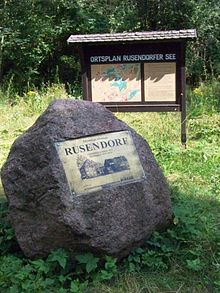Rusendorf
Rusendorf is a by lignite mining the open pit Phoenix Falkenhain between 1927 and 1933 desolate fallen village between Lucka and Meuselwitz . His corridor now belongs to the Falkenhain district of the city of Meuselwitz in the Altenburger Land district in Thuringia .
Geographical location
The place Rusendorf was between Mumsdorf in the west, Falkenhain in the north, Bünauroda in the east and Meuselwitz in the south. His corridor is now in Rusendorfer See . The memorial stone at Rusendorf is therefore not exactly in the area of the location.
history
From the foundation to the 19th century
On June 18, 1413, Rusendorf was first mentioned in a document. The name, which comes from Wendish, means “place of cattle width”. Rusendorf was a typical Slavic round settlement with agricultural production in 13 farms. For centuries the place had been legally dependent on the neighboring town of Falkenhain. In terms of church and school, Rusendorf was part of Zipsendorf until 1891 . On November 1, 1891, at the request of the Rusendorfer, the parish to Falkenhain took place. Since then, the Rusendorfer children have also attended school there.
Rusendorf is one of the few places in today's Altenburger Land district that historically did not belong to Saxony-Altenburg . Together with today also belonging to the Thuringia Meuselwitz places Brossen , Falkenhain and Zipsendorf was Rusendorf to 1815 in the office Zeitz , which as part of the Bishopric of Naumburg-Zeitz since 1561 under electoral Saxon stood sovereignty and between 1656/57 and 1718 for Sekundogenitur -Fürstentum Saxe-Zeitz belonged to. Due to the resolutions of the Congress of Vienna , the place came to Prussia in 1815 and was assigned to the Zeitz district in the administrative district of Merseburg of the province of Saxony in 1816.
Due to the political affiliation of Rusendorf and Falkenhain to Zeitz, it emerged that Mumsdorf , which was politically part of Altenburg , was an exclave of the Duchy of Saxony-Altenburg in the Zeitz monastery area and, since 1815, in Prussian territory. In 1890 73 people lived in Rusendorf.
Time of lignite mining
As a result of a mighty brown coal seam not too deep under the overburden , things changed in the corridor of Rusendorf from 1904 . The “Heureka-Phönix” mine acquired the northern part of the village in 1904 and the “Fürst Bismarck” mine acquired the southern part of the village in 1900/1906. This resulted in open-cast mines in the west of Rusendorf (Phönix-Mumsdorf open-cast mine) and south of the village (Fürst Bismarck I and II open-cast mines, Heureka open-cast mines). As a result, the connection route to Mumsdorf disappeared between 1906 and 1924 through the opencast mine of the same name. In 1912, the Fürst Bismarck mine cut its way to Meuselwitz in the south. In 1922 the route to Brossen in the southwest and Bünauroda in the east followed. After the connection to Falkenhain, located to the north, was cut in 1924, Rusendorf, located on the Thuringian-Prussian border, could only be reached via detours. On the one hand, Rusendorf suffered enormously from the lignite mining; on the other hand, it also increased the population of the place (1914: 123; 1925: 134). On November 1, 1921, the Rusendorf volunteer fire brigade was founded, seven of which were from Rusendorf. As early as 1925, the Rusendorf fire fighting train formed an independent unit.
Dissolution of the Rusendorf community
In 1927 the first families left the village and the demolition of Rusendorf began. On March 17, 1929, the volunteer fire department disbanded . The farewell service for the parishioners took place on July 17, 1932 in the Falkenhain church. Crowds had come from near and far. By decision of the Prussian State Ministry , the rural community of Rusendorf, Zeitz district , was incorporated into Falkenhain from October 1, 1932. At that time, Rusendorf only had one residence. The " Phoenix-Falkenhain open-cast mine " opened in 1928 destroyed the corridor of Rusendorf in 1934, which was the first place in the Meuselwitz-Altenburg lignite mining area to give way to lignite mining. By 1942, the opencast mine devastated the area south and east of Falkenhain. After its renaturation, the location of Rusendorf is in the Rusendorfer See .
With the territorial reform that took place in 1952, Falkenhain and the corridor of Rusendorf were reclassified from the Zeitz district to the Altenburg district in the Leipzig district . It has belonged to Thuringia since 1990. With the incorporation of Falkenhain on March 8, 1994, the Rusendorf corridor belongs to the city of Meuselwitz in the Altenburger Land district.
Memory of Rusendorf
At the request of the residents of Rusendorf, the memorial dedicated to the fallen fathers and sons of the First World War, inaugurated in 1927, was moved to the Falkenhain church , as was the bell from 1928 that was cast for Rusendorf and a memorial stone. As part of the 5th Meuselwitz city festival, a memorial stone for the town of Rusendorf was unveiled on September 1, 1995. It was donated by the Mitteldeutsche Braunkohlengesellschaft mbH (MIBRAG). Since the original location of Rusendorf is in the lake of the same name, the stone was set up on the Meuselwitz - Falkenhain - Bünauroda hiking trail, somewhat away from the original location of Rusendorf.
Web links
- Rusendorf at www.schnaudertal.de
Individual evidence
- ↑ Meßtischblatt 2875, Saxon No. 57: Meuselwitz, 1928; Table sheet from 1928 with the location of Rusendorf
- ^ Karlheinz Blaschke , Uwe Ulrich Jäschke : Kursächsischer Ämteratlas , Leipzig 2009, ISBN 978-3-937386-14-0 , p. 86 f.
- ^ The Zeitz district in the municipal directory 1900
- ↑ http://www.schnaudertal.de/meuselwitz/rusend.htm Retrieved on November 12, 2014
Coordinates: 51 ° 4 ′ 3.9 " N , 12 ° 17 ′ 33.3" E


